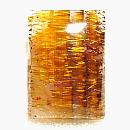|
|
||||||||||||||||
|
||||||||||||||||
|
||||||
|
|
|
|
Cacoxenite
(inclusions
in Quartz and Amethyst) |
|
| | |
| Discovered in 1825; IMA status: Valid (pre-IMA; Grandfathered) | ||
|
| ||
|
Chemistry |
|
|
| |
|
Fe2+24Al(PO4)17O6(OH)12 · ~75(H2O) | |
|
|
Hydrated Iron Aluminum Phosphate Oxide Hydroxide |
|
Molecular Weight: |
4,481.51 gm |
|
Composition: |
Aluminum |
3.76 % |
Al |
7.11 % |
Al2O3 |
|
|
Iron |
23.37 % |
Fe |
30.06 % |
FeO |
|
|
Phosphorus |
11.75 % |
P |
26.92 % |
P2O5 |
|
|
Hydrogen |
3.64 % |
H |
32.56 % |
H2O |
|
|
Oxygen |
57.48 % |
O |
|
|
|
|
|
100.00 % |
|
100.00 % |
= TOTAL OXIDE |
|
|
|
||||
|
Classification |
|
|
| |
|
Phosphates | |
|
7/D.11-50 | |
|
|
8 : PHOSPHATES, ARSENATES, VANADATES
|
|
Related to: |
None |
|
Varieties: |
None |
|
Synonyms: |
Cacoxene |
|
|
|
|
Crystal Data |
|
|
|
|
|
Crystals, may be crudely hexagonal, acicular along [0001], typically in compact concentric spherical to radial aggregates, to 8 mm; in bundles, randomly fibrous; as coatings or an intergranular cement. |
|
|
None |
|
|
|
|
|
Physical Properties |
|
|
|
|
|
None |
|
|
Irregular/Uneven |
|
|
Brittle |
|
|
3.0 - 4.0 |
|
|
2.20 - 2.60 (g/cm3) |
|
|
None |
|
|
Not Radioactive |
|
|
Other: |
Readily soluble in acids. |
|
|
|
|
Optical Properties |
|
|
|
|
|
Yellow to Brownish Yellow or Reddish Orange, Golden Yellow, deep Orange, rarely Greenish |
|
|
Semi-Transparent to Translucent |
|
|
Silky |
|
|
1.575 - 1.656 Uniaxial ( + ) |
|
|
0.060 |
|
|
None |
|
|
Visible; 0 = pale yellow; E = canary-yellow to yellow-orange |
|
|
|
|
|
Occurances |
|
|
|
|
|
Geological Setting: |
A common accessory mineral in oxidized magnetite and "limonite" iron ores; in Fe,Mn-bearing novaculites; a rare constituent of iron-rich sediments and soils. |
|
Common Associations: |
Beraunite, Dufrenite, Rockbridgeite, Strengite, "Limonite", Magnetite, Wavellite. |
|
Common Impurities: |
Al |
|
Type Locality: |
Hrbek Mine, Svatá Dobrotivá (St Benigna), Beroun (Beraun), Central Bohemia Region, Bohemia (Böhmen; Boehmen), Czech Republic |
|
Year Discovered: |
1825 |
|
View mineral photos: | |
|
|
|
|
More Information |
|
|
|
|
|
| |
|
|
|
|
Cocoxenite
is widespread in small amounts. In the Czech Republic,
from the Hrbek mine, Svatá Dobrotivá (St. Benigna);
at Trenice; from Zbirov; and at Cerhovice. In Germany,
from the Eleonore and Rotläufchen mines, near Giessen,
Hesse, and at Hiihnerkobel, near Zwiesel, Bavaria. In
France, at Rochefort-en-Terre, Morbihan. From Shanagolden,
County Limerick, Ireland. At Kiruna, Sweden. In the
USA, from the Palermo #1 mine, near North Groton, Grafton
County, New Hampshire; from Pennsylvania, at Hellertown,
Northampton County, Moore's Mill, Cumberland County,
and Noble's mine, Lancaster County On Indian Mountain,
Cherokee County, Alabama, groups large for the species;
in the Wilson Springs (Potash Sulphur Springs) mine,
Garland County, from the Avant claim, about three km
southwest of Shady, and at Three Oak Gap, Polk County,
Arkansas; in the Vanleer mine, Iron City, Lawrence County,
Tennessee; from the Palmetto mine, southwest of Bartow,
Polk County, Florida. |
|
|
We
have not photographed our Cacoxenite gems
yet. Please
check back soon. |
